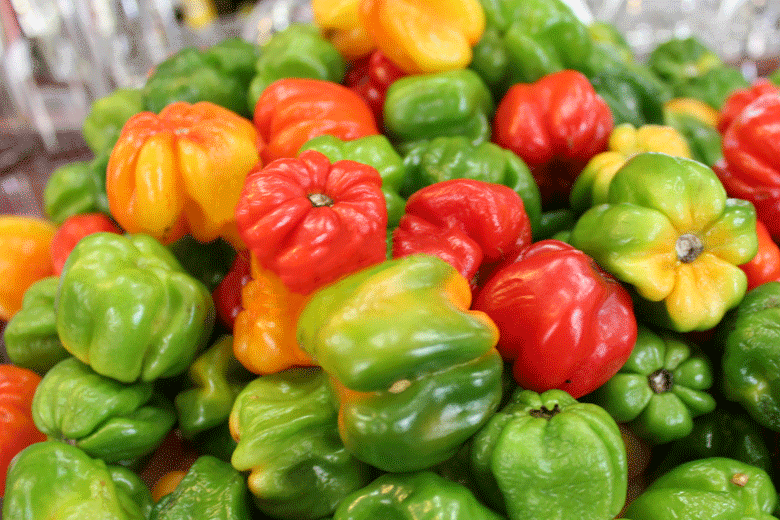Scotch Bonnets are a favourite
For me, this is always a fun time of the year. After having grown Chilies for the last eight months, now is the time to begin cooking with them. This post will be the first in a series I intend to write about the Chillies I harvest for this season. I want to delve into how these Chillies can be used in cooking. In the first of these posts, I explore cooking with Scotch bonnets.
Earlier this week, I harvested some yellow Scotch bonnets from a plant I overwintered from last year. All in all, I picked forty pods from this plant alone.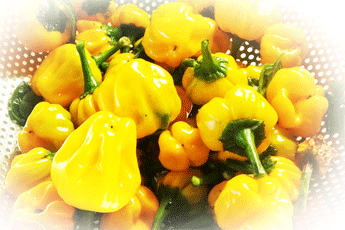 The plant still has about ten pods on it, so by the time these ripen the plant will have delivered about fifty Chillies. That’s not bad for a single plant.
The plant still has about ten pods on it, so by the time these ripen the plant will have delivered about fifty Chillies. That’s not bad for a single plant.
I am really happy with this result, as Scotch bonnets are one of my favourites. It is such a versatile Chilli with loads of flavour and there is so much you can do with them.
They are quite hot Chillies with a Scoville rating of between 100000 and 350 000 SHU, but by not using too many in any one dish, this heat is quite tolerable. I have previously made seriously good hot sauce with Scotch Bonnets. I have also dried them to make Chilli flakes, used them in curries , and made jerk chicken. There are however many more uses for Scotch bonnets in cooking. To help me decide how I will use these Chillies, I will explore where Scotch Bonnets are used elsewhere.
Where are Scotch Bonnets used?
 Uses in cooking
Uses in cooking
Scotch bonnets are popular in Caribbean cooking. They are used extensively in Jamaica, Trinidad and Tobago, Barbados and other countries in the West Indies. Dishes like Jerk Chicken, Jollof Rice, Jamican beef patties and Haitian pork grigot are made with Scotch bonnets. Scotch bonnets are also used in Caribbean curries, like Goat curry and Jamaican curry chicken. These curries have a distinctly Caribbean taste to them. They are made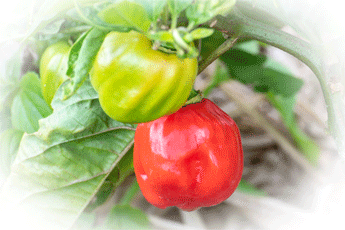 using spicing unique to curries made in the West Indies. This spicing combines spices typically used in Indian cooking with Pimento. Pimento or Allspice is a spice widely used in Caribbean cooking.
using spicing unique to curries made in the West Indies. This spicing combines spices typically used in Indian cooking with Pimento. Pimento or Allspice is a spice widely used in Caribbean cooking.
Scotch bonnets are also popular in the United Kingdom. It is a Chilli that is quite freely available and can easily be bought from supermarkets. In the United Kingdom, besides being used in Caribbean cooking, Scotch bonnets are used in making curry. A typical curry might contain one or two Scotch bonnets. One curry, though that has its origins in Birmingham, contains far more. Phaal, which is the hottest curry in the UK, can contain as many as twelve Scotch bonnets. To put this into context, twelve Scotch bonnets have the same amount of Capsaicin (the stuff that makes Chillies hot) as roughly five hundred Jalapenos. It is very hot indeed. Phaal is certainly not for the faint-hearted
Habaneros and Scotch bonnets
Are they the same?
The shot answer is no. While they both are from the same species (Capsicum Chinense), they are different. Scotch bonnets are from Jamaica, and Habaneros are indigenous to Mexico. Both these Chillies probably had their origin in South America. They travelled very different paths to get to where they are today.
While Scotch bonnets are closely related to Habanero Chillies, they do however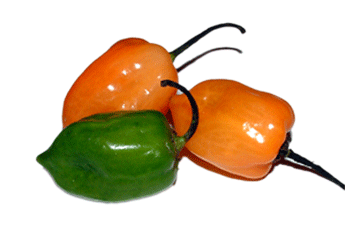 differ in appearance. The Scotch bonnet is squatter than the Habanero. The Habanero is teardrop-shaped, whereas the Scotch bonnet is shaped more like a globe. The Scotch bonnet gets its name from the Scottish “Tam o shanter “ cap because it resembles the shape of this bonnet.
differ in appearance. The Scotch bonnet is squatter than the Habanero. The Habanero is teardrop-shaped, whereas the Scotch bonnet is shaped more like a globe. The Scotch bonnet gets its name from the Scottish “Tam o shanter “ cap because it resembles the shape of this bonnet.
The flavour of Scotch bonnets and Habaneros is similar, with subtle differences. Scotch bonnets are probably a bit sweeter, and Habaneros have a smokier flavour. For most purposes, however, these differences are virtually unnoticeable
This makes Scotch bonnets an ideal substitute for Habaneros in Mexican cooking. Mexican dishes that can be made with Scotch bonnets include Moles, salsas, Frijoles Puerco’s (refried beans with Chorizo, Habaneros and cheese), tacos and Mexican pickled onions. Other Mexican dishes and sauces that can be made with Scotch bonnets are Salpicon (a sauce made with bitter oranges and Habaneros, Mexican brownies. Green Pepita sauce (made with pumpkin seeds, tomatillos and Habaneros, Gaucamole and Mexican Ceviche.
Other uses for Scotch Bonnets
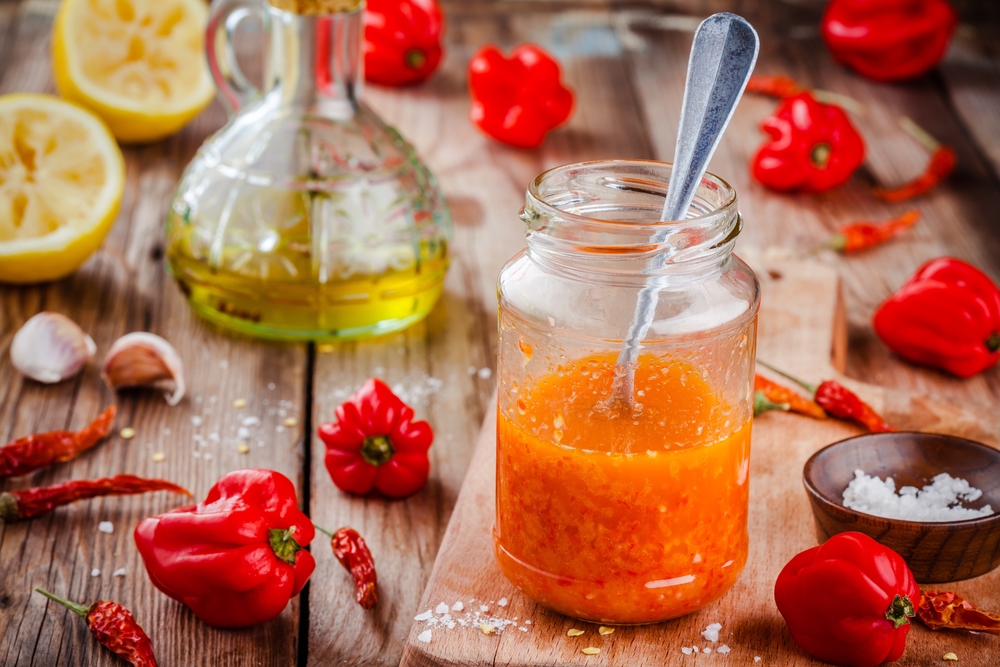 Soups, jam and pasta
Soups, jam and pasta
I personally am not a fan of superhot foods. I enjoy a certain amount of heat in my food, but when it comes to blowing your socks off with Chillies, you can keep it. To me, Chillies are not only for providing pungency, but are also there for flavour. Scotch bonnets have a sweet fruity flavour. This makes them ideal for not only hot sauces but also for making jams and chutneys. Scotch Bonnet pepper jelly is a typical Jamaican jam made with these Chillies. It contains bell peppers, Scotch bonnets, grapefruit peels, horseradish, vinegar and various other spices.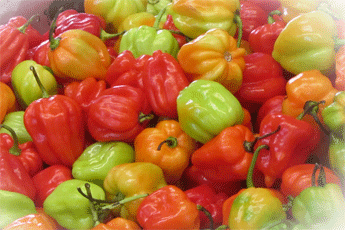
Other uses for Scotch bonnets are in soups, sauces, and to make Chilli oils. An example of a soup made with Scotch bonnets. Spicy peanut and squash soup is a typical soup made with these Chillies. While other Chillies are traditionally used to make soups like Vietnamese Bun Bo Hue and Prawn and Chicken Laksa from Malaysia, there is no reason why Scotch bonnets can’t be used to make these recipes.
Chilli oils are easily made with Scotch bonnet Chilies. Chilli oils are a must-have for any larder. They can be used to add a touch of spiciness to everything, including stir-fries, noodles, and pasta dishes eggs. Pasta and noodles in particular are really good with Chillies. In the Carribean, this is recognised in dishes like Macaroni Pie. This dish served with stews or barbequed chicken.
In addition, Scotch bonnets are also used in Caribbean cooking to make stews and hot pots, like Caribbean pepperpot stew , Chivo Guisado (a goat meat stew from the Dominican Republic stew peas, Jamaican stewed oxtails and Carribbean Stew Chicken.
Finally
Scotch bonnets dry really well. Consider drying them if you have a big harvest and have run out of uses for your Scotch Bonnets. Once dried, they can be ground in a grinder into Chilli powder or Chilli flakes and Jerk seasoning. These can then be used, like Scotch Bonnet Chilli oil, to add zest to foods. Another way of preserving Scotch bonnets is by freezing them. There is no need to defrost the Chillies after they have been frozen. They can simply be chopped up in their frozen state and added to your favourite dishes.
And after all this, what have I decided to make with my Scotch Bonnets? The Jamaican Scotch bonnet jelly sounds fabulous. However, I don’t have any grapefruit. Not a problem though. I am reasonably sure that using lemons (which I do have) won’t make that much of a difference. Let’s wait and see!
Image credits
Manu486 at fr.wikipedia/ Public domain,/via Wikimedia Commons
Eric Chaffee / CC BY-SA 2.0 / via Flickr

